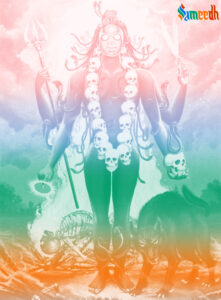Bhairav is considered a form of Lord Shiv in Hinduism. Bhairav is a fierce manifestation of Shiv, associated with the aspect of destruction and dissolution. The name “Bhairava” is derived from the Sanskrit words “bhīru,” meaning fearful, and “va,” meaning to carry or bear. Bhairav is often depicted as a fearsome deity, and his worship is believed to bring about the destruction of ego and ignorance.

Bhairav, also known as Kaal Bhairav, is a fierce and wrathful form of Lord Shiv in Hinduism. Bhairav is often associated with time and is considered the lord of time or “Kaal” in its destructive aspect.
Bhairava is often regarded as the guardian of sacred spaces, such as cremation grounds. In this role, he is associated with the transformative power of death and regeneration.
Here are some key aspects of Bhairav:
- Fierce Form: Bhairav is depicted with a terrifying appearance, often having a fierce expression, sharp teeth, and a crown made of skulls. This ferocious form symbolizes the destructive and transformative aspects of time.
- Multiple Forms: There are various forms of Bhairav, each associated with different aspects of Shiv’s power. Some well-known forms include Kala Bhairav (the lord of time), Ruru Bhairav, Chanda Bhairav, and others.
- Kaal Bhairav: This form is specifically associated with time and is believed to be the guardian of the eight directions, controlling the moments of time in the universe. Devotees believe that Bhairav is present in all moments, and he is the one who governs the cyclical nature of time.
- Worship and Rituals: Bhairav is worshiped by devotees seeking protection, as well as those who wish to overcome obstacles and challenges in their lives. Special rituals and prayers are performed on Tuesdays and Sundays, which are considered auspicious for Bhairav worship.
- Symbolism: Bhairav’s wrathful form represents the inevitability of time and the transient nature of all things in the material world. By worshiping Bhairav, devotees seek to transcend the limitations of time and attain spiritual liberation.
- Dog as a Companion: In many depictions, Bhairav is accompanied by a dog, symbolizing his role as the guardian of the cremation grounds and his ability to transcend conventional norms.
The worship of Bhairav is believed to lead to spiritual transformation, helping devotees overcome fear, attachments, and negative influences. Devotees may seek his blessings for protection and guidance on the spiritual path. Devotees of Bhairav believe that worshiping him with sincerity and devotion can help in overcoming fear, dispelling obstacles, and attaining spiritual growth. The worship of Bhairav is also associated with the removal of sins and protection from negative forces.
